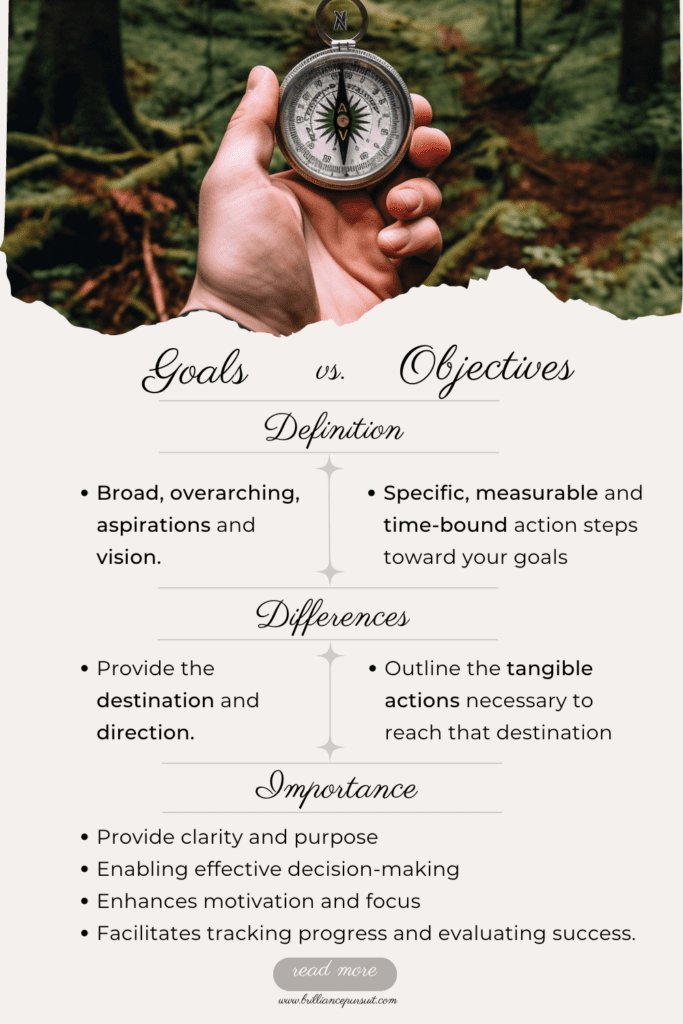Differentiate Goals vs Objectives and 4 practical Steps to Success
Understanding the Difference Between Goals and Objectives for Successful Planning
When it comes to planning, understanding the difference between Goals vs Objectives is crucial. While they are both important components, they serve different purposes and require specific approaches. By clarifying the difference between goals and objectives early on, you can avoid getting stuck, losing focus, or feeling overwhelmed throughout your journey toward success.
1. Goals vs Objectives: What is the Difference?
Definition of “Goals”:
Goals are like the big picture you have for your life. They embody your dreams and the vision you have for yourself or different areas of life. Examples could be as broad as “a life filled with happiness and fulfillment” and “starting your own successful business” or a bit more specific, like “exploring the wonders of the world” or “losing 10 pounds”.
- Goals are the vision that is broader and intangible
- They are often abstract (like finding happiness or fulfillment)
- They can be subjective and open to interpretation (like, for example, saying „I want to be pretty/rich/successful“ – which can mean different things to different people)
So, it can be said that goals are like the overall vision you have—the summit you want to reach. However, at this stage, you haven’t defined the specific path that will take you there.
Definition of “Objectives”:
Objectives, on the other hand, are more specific and tangible. They are measurable and time-bound actions that need to be achieved to reach your goals. Often, people confuse goals and objectives because setting “SMART goals” is a widely discussed topic.
Objectives are like the concrete milestones you need to hit in order to achieve your dreams. For example, if your goal is to participate in a marathon, you might start by training for a 5K race if you’ve never done anything similar before. Once you achieve that, you can aim for a 10K race, a half marathon, and eventually strive for a full marathon.
- Objectives are trackable, specific, and less open to interpretation
- They are the concrete milestones to reach your goal
- They help to keep track of your progress and stay accountable
Overall, it can be concluded, that Goals are the destination where you want to end up (e.g., the mountain peak), and Objectives are the directions to get there (e.g., the different routes to reach the summit).
2. Goals and Objectives: 4 Steps to Transform Your Goals into Action
Now that you have a clear understanding of the difference between goals vs objectives, it’s time to establish a proven process that will transform your ideas into actionable plans. By following these four steps, you can maximize your chances of success:
Step 1: Identify Your Goals
Begin by identifying what you want to achieve in the long run. Your goals should align with your values and passions. You can work towards one overarching goal, multiple areas of life, or a combination of both. However, avoid overwhelming yourself with too many goals at once. Start small, establish a process, and then add other goals to your list.
Step 2: Break Down Your Goals into Objectives
To define your goals in more detail and increase your chances of success, break them down into specific objectives. This is where the concept of “SMART goals” comes into play. Each objective should be specific, measurable, attainable, relevant, and time-bound.
Step 3: Develop an Action Plan Based on Your Objectives
Once you have defined your SMART goals or objectives, it’s time to create a valuable action plan. This plan should outline the steps you need to take to achieve your objectives and, ultimately, your goals. Prioritize your objectives based on their importance and impact on your overall goals.
In your action plan, include reasonable timelines, deadlines, and the resources you need to complete each task. Additionally, consider potential distractions that could derail your progress and find ways to mitigate them.
Step 4: Monitor and Adjust
Monitoring your progress is crucial to staying focused on your goal, especially when life gets busy, other priorities arise, or motivation wanes. Use habit trackers or other tools to keep track of your actions and measure your progress.
Regularly review your objectives and action plan. Be flexible and willing to adjust your plan if necessary. By monitoring and adapting, you ensure that you stay on the right track toward achieving your goals.
3. Conclusion
Understanding the distinction between goals and objectives empowers you to pursue your dreams and aspirations effectively. In summary, goals are the broader, intangible visions you strive to achieve, while objectives are the specific, measurable, and time-bound actions that serve as milestones along the way.
By gaining clarity on your goals, defining the milestones that lead to them, and measuring your progress, you can evaluate and adjust your actions effectively. Stay flexible, enjoy the journey, and take action towards your goals today!









